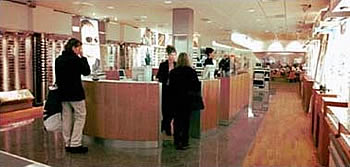 |
| Courtesy of www.contacta.nu |
Contacta has a history of fitting contact lenses for Extended
Wear since the beginning of seventies. Contacta's philosophy is
to fit the best available product for each patient at all time.
One of them is silicone hydrogels. Contacta have now been fitting
silicone hydrogels since 1998.
The Swedish history of extended wear
Mr Klas Nilsson from Gothenburg in Sweden started to develop a
lathe cut soft high water content lens in the beginning of the
seventies. He was then the owner of Contacta. The lens was based
on vinylpyrrolidone and methylmethacrylate and was launched in
1975. The name of the product was Scanlens 75 (S-75). The lens
was 72% water content. Initially Klas Nilsson got a really good
start with his lens for Extended Wear. After a while negative
responses occurred, with intolerance and discomfort due to tight
fits. The lens became successful when the lens was fitted very
loose and with a small diameter, and was frequently replaced,
normally every six months. Still some patients did get jellybumps
and mechanical problems with this thick lens.
The allergic problems from the solutions (thimerosal) also became
sometimes a problem. The knowledge that Klas fitted Extended Wear
lenses became very popular and the number of patients increased
very quickly. In Sweden it was a problem at that time to find
optometrists to fit Extended Wear lenses. Klas Nilsson was the
first person in Sweden to start a training program for fitting
contact lenses. It was called the contact lens technical education.
To fit contact lenses for extended wear wasn't so popular from
the optometrist and ophthalmologist point of view then. Mr. Nilsson
thought he knew what the patients really wanted and it was Extended
Wear lenses.
The criticisms and fear of fitting Extended Wear lenses was maybe
more based on a political thoughts then clinical experience and
facts.
In that period it became like two camps in Sweden - the optometrists
who fitted Extended Wear and those who didn't like it at all.
In 1986 Klas Nilsson got the greatest award an optometrist can
get in Sweden, The Gullstrand medal. In the end of the eighties
and beginning of nineties the S-75 lens was the most common fitted
lens in Sweden, though on a daily wear basis.
Mr. Nilsson later sold his production of S-75 to CIBA Vision.
During the nineties the Acuvue lens started to be more popular
to fit on Extended Wear basis. Most of the mechanical and allergic
problems disappeared when we got the thinner lens. Frequent replacement
with the lens did have a positive effect on the patients' eyes,
though most of the optometrists in Sweden fitted them on a daily
wear basis.
Silicone hydrogels
In 1998 we were introduced to the new silicone hydrogels. We participated
in a Swedish study with PureVision. 500 patients went through
the one year long study, with 40 at Contacta in Gothenburg. We
had at that time still a large number of extended wear patients
with S-75.
It wasn't difficult for us to convert our patients from the now
old S-75 in to silicone hydrogels. Everything was better with
this type of lens except the freedom. It was the same as before.
They didn't need to take the lens out. Contacta has today nearly
2500 patients with silicone hydrogels.
As with any type of new lens we have seen negative responses
but we've learnt more and more about them.
The negative response we have seen is: SEALs (Superior Epithelial
Arcuate Lesion), CLPUs (Contact Lens Peripheral Ulcers), CLPC
(Contact Lens Papillary Conjunctivitis), and poor wettabillity
on the surface of the lens.
The SEALs problem seems to decrease with the newer 8.4 basecurve
design.
The CLPU problem seems to increase in the period when people
easily get a cold, but it is one of the problems we do not know
why they appear.
The CLPC problem is quite a rare problem. The local CLPC problems
do we see more often. In some cases this may be caused by too
flat a fit or the lens might has been inserted inside out.
The poor wettability we see sometimes occurs when the lipid layer
of the tearfilm is too thick. The lipid layer seems to hold on
to the surface and the patient complains of dry eyes. Smoking
may be an issue in causing problems with the wettability on the
surface.
We also see mucin balls with silicone hydrogels. Mucin balls
appear on the surface of the cornea. We have found that the number
of mucin balls decreases when the lens fit gets steeper.
When a patient hasn't worn contact lenses before, we start with
daily wear for one or two weeks to be sure that the handling isn't
a problem.
Our follow up schedule is as follows:
- Initial visit
- One night
- One week
- One month
- 6 months
- After the first 6 months we examine the patient 2 times a
year.
We have now been fitting silicone hydrogels since 1998. What
we have noticed during the period is that our patients are very
satisfied with their concept of wearing the lens overnight. The
convenience and the freedom are important factors for our contact
lens patients. |